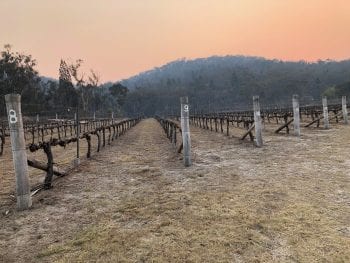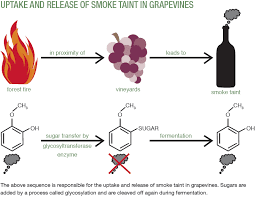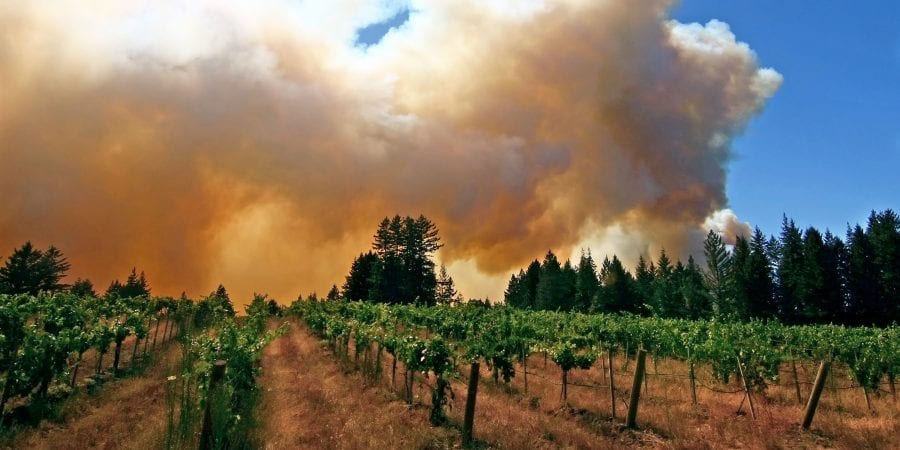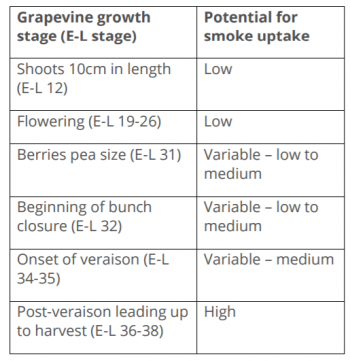This week my heart goes out to all those affected by the horrendous bushfires throughout NSW and QLD. Thank goodness it’s only houses which have been lost so far. Not like that is a good thing either… but it could be a lot worse.
And for those who have managed to save their homes, there is the clean-up and longer-lasting effects which grape growers (and others of course) need to start thinking about in the aftermath.
 I know of a grower in Ballandean, Queensland who was evacuated from their home this week. The only thing standing between their house and the fire was their vineyard. The photo on the left was taken at their property this week… check out just how dry everything is.
I know of a grower in Ballandean, Queensland who was evacuated from their home this week. The only thing standing between their house and the fire was their vineyard. The photo on the left was taken at their property this week… check out just how dry everything is.
So, it got me thinking about what’s next for those growers.
The good news for them is that it is still very early in the season. The vines haven’t yet burst, so the impact will be minimal.
As we know though, there are too many examples of when growers have not been so lucky….
In 2015, bushfires which started in Sampson Flat northeast of Adelaide burnt 12,500 hectares of land. At least 35 hectares of vineyards were damaged directly by the fire, across seven wineries in the Adelaide Hills.
And we all know how devastating the 2009 Black Saturday bushfires in Victoria were.
But it was the fires in Canberra in 2003 which led the Australian Wine Research Institute (AWRI) to carry out an in-depth investigation into whether smoke affected wine and if so, how.
What is ‘smoke taint’?
As the name suggests, smoke taint is an undesirable characteristic in wine when the grapes are exposed to smoke.
And although we talk about those typical smokey characteristics of a wine which is aged in oak barrels… it’s definitely not that. Common descriptors for smoke-tainted wines include burnt, medicinal and campfire. The best quote I read during my research on this topic was came from a guy in California who said… “if you’re particularly fond of licking wet ashtrays, you’ll like this wine.”
 Unfortunately, smoke taint isn’t caused by just a residue on the grape. You can’t wash it off. When wood burns, it releases aroma compounds called volatile phenols. In the vineyard, these compounds can permeate the grape skins and rapidly bond with the sugars inside to form molecules called glycosides.
Unfortunately, smoke taint isn’t caused by just a residue on the grape. You can’t wash it off. When wood burns, it releases aroma compounds called volatile phenols. In the vineyard, these compounds can permeate the grape skins and rapidly bond with the sugars inside to form molecules called glycosides.
This process, called glycosylation, renders the phenols no longer volatile, meaning their smokiness cannot be detected by smell or taste. However, once the grapes are fermented, the acidity in the resulting wine will begin to break these bonds, rendering the phenols volatile once again.
This typically happens during fermentation but can continue to occur after the wine has been bottled. It can even happen right as you take a sip: The enzymes in your mouth are able to break down any glycosides that remain, and the undesirable aromas can be vaporised as you taste. A wine might smell fine but taste off.
Factors which affect the uptake of smoke taint
According to the AWRI, the risk of smoke exposure causing a perceptible taint in wine is determined by a number of factors, including…
- stage of grapevine growth and development,
- the grapevine variety exposed,
- smoke composition,
- duration of exposure
 Stage
Stage
Research has shown that the period between veraison and harvest is when grapes are most susceptible. Check out the table on the right for information on all the different growth stages.
Variety
It has become apparent that certain varieties seem more susceptible to smoke taint. But the jury is still out on exactly which ones and why. More research is being done in this area. But for now, it is believed that thicker-skinned varieties are better off. So, Sangiovese is more sensitive than Cabernet Sauvignon.
You won’t see smoke taint in white wines nearly as much as you would in reds, since the compounds are concentrated in the skins, and whites don’t typically sit on their skins during fermentation as reds do.
Composition
The exact amount of smoke exposure which results in a perceptible taint in wine is not well known. This is because the chemical composition of smoke changes rapidly in the atmosphere. It becomes lower in the concentrations of volatile phenols over time. This means that smoke from recently burnt woody materials will contain higher concentrations of free volatile phenols, and will have greater potential to cause smoke taint in grapes and wine.
Duration
A 2008 study, conducted in part by Western Australia’s Department of Agriculture and Food (DAFWA), found that even 30 minutes of heavy smoke exposure to grapes could cause smoke taint in subsequent wines. So “not long” is the answer to that one!
Detection
Research into methods for detecting smoke taint is ongoing.
Currently, winemakers can send samples of grapes and juice to research institutions or private companies, where they will be tested for volatile phenols such as guaiacol and 4-methylguaiacol, two of the most common markers of smoke taint. Low levels of these compounds naturally exist in wines. Oak-aged, non-tainted wines can have even more.
Though we know high levels of these compounds will indicate smoke taint, there is no threshold level that will definitely signal that. It depends on how much volatile phenol is released during the winemaking process. And to figure that out you have to… make the wine. Not the greatest use of your time and money if you’re going to end up with a smoke tainted wine.
So, current tests can be good indicators that smoke taint may be present, but they are not a guarantee it’s not.
What Can Winemakers Do?
Even if vineyards and grapes are exposed to smoke, it’s not the end of the world for their wines. The AWRI has come up with around a dozen practical tactics for managing smoke-exposed fruit. The key ones being…
- Hand harvest fruit to minimise breaking or rupturing of skins (where the volatile phenols are)
- Exclude leaf material to limit smoke-related characteristics (the leaves adsorb the phenols as well)
- Avoid maceration and skin contact during the winemaking process
- Keep fruit cool to extract less smoke-related compounds
- Whole bunch press to reduce extraction of smoke-derived compounds
In addition to these strategies, advances are happening all the time.
And, as you have probably guessed, Australian entities like the AWRI along the University of Adelaide are considered the world leaders in smoke taint and other fire-related winemaking issues. We’re in pretty good hands.
A good news story…
I asked Rob about smoke taint. And while he was a little sketchy on the specifics, he recalls one story of some of the larger wineries buying smoke affected grapes from small growers after the fires in the Yarra Valley. They paid money for these otherwise useless grapes and blended them into large volumes of wine destined for bag-in-box. The quantity of smoke affected grapes was small in comparison and made the smoke taint virtually undetectable in the finished wine.
What a lovely positive story to come out of something so devastating.

 Stage
Stage